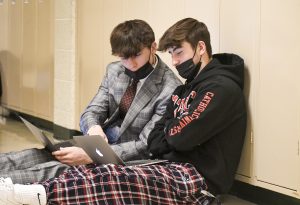No group work, more lunch space as COVID rates increase
Sophomores Riya Mahanta, Maya Jaiswal, and Irene Shin eat their lunch in the black box theater on Wednesday, Jan. 26.
February 1, 2022
Due to the recent rise in COVID-19 cases, many students feel uncomfortable eating in the cafeteria since there is no enforced social distancing, prompting the school administration to designate additional lunch areas around the school. Meanwhile, social distancing in classrooms has become more regulated.
Since Jan. 3, students have been required to sit in rows in classrooms, and they have been prohibited from participating in group activities. However, during lunch, students are allowed to sit however they like without masks—often at crowded tables with little distance between them.
According to the CDC (Centers for Disease Control and Prevention), students learning in-person should wear masks inside, regardless of whether they are vaccinated and they recommend schools maintain at least three feet of physical distance between students within classrooms to reduce transmission risk.
Principal Sean Bevan hopes teachers will have more flexibility in classroom seating and group work soon.
“Group work is so powerful and important for instruction, but it also results in kids being in close contact with each other,” Bevan said.
Bevan said that depending on COVID-19 rates and transmission risk, there could be additional changes to the learning environment. While he expects only small changes, he noted that if there is a big risk, then a significant change could happen.
Nurse Erika Almquist explained that the Mass. Department of Elementary and Secondary Education (DESE) makes recommendations depending on local case counts.
“I think a change from DESE for decreasing restrictions in general [would happen] basically if cases go down in our community,” Almquist said.
Though it is a possibility school may go back to remote learning through Zoom, Almquist and nurse Heather Allen say it doesn’t seem very likely because DESE prefers students to learn in-person.
“I don’t think DESE really wants us to go back to Zoom and prefers that school stays in-person,” Allen said. ”The days that are remote don’t count [towards the required 180 school days], and I think as students you should try to distance yourself as much as you can inside during lunch, especially with a mask off.”
Eating lunch at school without the ability to social distance makes many students feel uncomfortable. According to a Harbinger survey of 127 students via Google forms from Jan. 3 to Jan. 5, 78% of respondents said they don’t sit at least six feet apart from other students during lunch, and 22% said they always put their mask on immediately after eating. In addition, only a small minority of students, 16%, feel “very safe” from potential COVID-19 exposure during lunch.
“I don’t feel very safe during lunch,” junior Jessica Regan said. ”There are a lot of people near me at my table, and there’s been a lot of COVID cases. I don’t want to get it myself.”
As of Jan. 3, administration opened up more lunch spaces for students who don’t feel comfortable in the cafeteria. Students may eat lunch in the Black Box theater and, with guidance counselor permission, in the CRC. Weather permitting, they can also eat outside.
“I like the Black Box theater,” senior Celine Goncalves said. “I think it is really good because I feel safe, and I can try to be at least six feet apart from others.”













